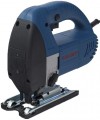Type
—
Portable. Relatively compact tool; during cutting, such a jigsaw is held in the hands and must be moved relative to a stationary workpiece. The main advantage of such models is obvious from their name — it is easy to carry: the jigsaw can be easily moved not only between work sites, but also between different jobs within the same site. On the other hand, portable models are less suitable for long-term work than stationary models — although their weight is relatively small, it is still quite significant, and holding on weight for a long time can be very tiring.
—
Stationary. Jigsaws of this type resemble miniature sawmills: they have a base on which a frame with a saw blade is fixed, and the frame does not move during operation — instead, the operator must feed the workpiece in the right direction. Such tools are not as mobile as portable ones, they are noticeably heavier and more expensive, but they are much better at handling large volumes of work.
Power consumption
The maximum electrical power consumed by the jigsaw during operation. It is worth noting that this parameter uniquely determines only the amount of electricity spent on the operation of the tool; its practical characteristics, for example, the thickness of the material and the speed of operation, depend primarily on the output power (see below). On the other hand, the output power is not always indicated by the manufacturer, and therefore a comparison by power consumption is quite acceptable — to a certain extent, it allows you to evaluate the characteristics of the tool. So, it is believed that electric jigsaws up to 600 W are enough for domestic use, and
more powerful models belong to the professional segment. For more information on selecting a jigsaw for power, see "Output Power".
Minimum frequency
The minimum stroke frequency of the jigsaw blade during operation. In some cases (for example, when working on metal), a low stroke rate is preferable to a high one; accordingly, the lower the minimum frequency, the more opportunities you will have to set up the instrument for working on a particular material.
Max. frequency
The maximum stroke frequency of the jigsaw blade during operation. The
higher the stroke rate, the higher the performance of the tool and the cleaner and more accurate the cut, usually. On the other hand, high speed is not optimal for all materials; picking up a "high-speed" jigsaw is worth it if it is planned to be used mainly for woodworking.
Also note that the characteristics of the tool usually indicate the maximum frequency at idle; at work, it is usually less. However, this parameter quite allows you to compare different tools with each other.
Pendulum action
Possibility of work of a fret saw in the mode of the
pendular course. In this mode, the working blade moves not only up and down, but also back and forth in such a way that contact with the material and sawing are carried out only when moving up. It is believed that the pendulum mode can increase the speed of work (especially when working with thick materials) and increase the life of the file. On the other hand, the quality of the cut using the pendulum stroke is worse than in the normal mode, and therefore it is not recommended to use it for precise work.
Stroke
The length of the stroke of the working blade of the jigsaw during operation. The longer the stroke, the more of the file will be in contact with the material in one movement; accordingly, at the same frequency of movement of the blade, a jigsaw with a longer stroke length will be more performant.
Shoe sizes
The size of the sole of the jigsaw is a plane that, during operation, is closely pressed against the workpiece and ensures its correct position relative to the saw blade. This parameter is important primarily for stationary models (see "Type"). On the one hand, a large sole makes it easier to work with large sheets of sawn material (especially if the thickness of such a sheet is small and it tends to bend); on the other hand, this indicator significantly affects the weight and dimensions of the unit. However, some manufacturers indicate the size of the sole for a portable tool.
Handle
The shape of the jigsaw handle determines the way it is held during operation, as well as some application features. Today the following types of handles are used:
—
D-shaped. Sometimes also called “staple-shaped”. True to its name, it is shaped like the letter “D” rotated 90°. The advantage of such jigsaws is the ability to work with one hand; on the other hand, they are poorly suitable for figured sawing, especially with complex shapes of cuts.
—
Mushroom-shaped(rounded holder). In our catalog, this category includes all jigsaws equipped with an additional protrusion holder in the front part. This protrusion makes it easier to hold the tool with both hands, which is especially important when making cuts of complex shapes. Accordingly, such tools are considered more suitable for figure sawing. Among the disadvantages, visibility during operation is somewhat worse than in the case of a D-shaped handle.
Wood
Maximum cutting depth in wood, in other words — the maximum thickness of a wooden workpiece that a jigsaw can handle. This parameter characterizes not only directly the maximum thickness of the material, but also the performance of the tool as a whole: the greater the depth of cut, the higher the performance. In the case of wood for domestic use, a depth of about 70 mm is considered sufficient, deeper models are usually professional.
It is worth noting that the depth of cut is usually indicated for certain files recommended by the manufacturer for a particular material. The use of other canvases does not guarantee compliance with the claimed parameters, and in some cases it is even fraught with breakdowns and injuries.

